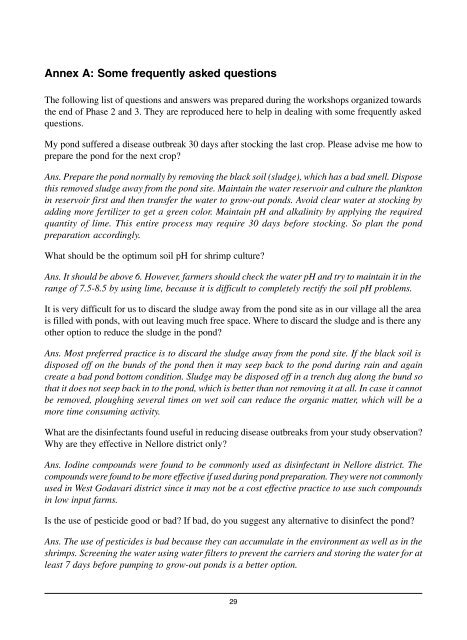Shrimp Health Management Extension Manual - Library - Network of ...
Shrimp Health Management Extension Manual - Library - Network of ...
Shrimp Health Management Extension Manual - Library - Network of ...
You also want an ePaper? Increase the reach of your titles
YUMPU automatically turns print PDFs into web optimized ePapers that Google loves.
Annex A: Some frequently asked questionsThe following list <strong>of</strong> questions and answers was prepared during the workshops organized towardsthe end <strong>of</strong> Phase 2 and 3. They are reproduced here to help in dealing with some frequently askedquestions.My pond suffered a disease outbreak 30 days after stocking the last crop. Please advise me how toprepare the pond for the next crop?Ans. Prepare the pond normally by removing the black soil (sludge), which has a bad smell. Disposethis removed sludge away from the pond site. Maintain the water reservoir and culture the planktonin reservoir first and then transfer the water to grow-out ponds. Avoid clear water at stocking byadding more fertilizer to get a green color. Maintain pH and alkalinity by applying the requiredquantity <strong>of</strong> lime. This entire process may require 30 days before stocking. So plan the pondpreparation accordingly.What should be the optimum soil pH for shrimp culture?Ans. It should be above 6. However, farmers should check the water pH and try to maintain it in therange <strong>of</strong> 7.5-8.5 by using lime, because it is difficult to completely rectify the soil pH problems.It is very difficult for us to discard the sludge away from the pond site as in our village all the areais filled with ponds, with out leaving much free space. Where to discard the sludge and is there anyother option to reduce the sludge in the pond?Ans. Most preferred practice is to discard the sludge away from the pond site. If the black soil isdisposed <strong>of</strong>f on the bunds <strong>of</strong> the pond then it may seep back to the pond during rain and againcreate a bad pond bottom condition. Sludge may be disposed <strong>of</strong>f in a trench dug along the bund sothat it does not seep back in to the pond, which is better than not removing it at all. In case it cannotbe removed, ploughing several times on wet soil can reduce the organic matter, which will be amore time consuming activity.What are the disinfectants found useful in reducing disease outbreaks from your study observation?Why are they effective in Nellore district only?Ans. Iodine compounds were found to be commonly used as disinfectant in Nellore district. Thecompounds were found to be more effective if used during pond preparation. They were not commonlyused in West Godavari district since it may not be a cost effective practice to use such compoundsin low input farms.Is the use <strong>of</strong> pesticide good or bad? If bad, do you suggest any alternative to disinfect the pond?Ans. The use <strong>of</strong> pesticides is bad because they can accumulate in the environment as well as in theshrimps. Screening the water using water filters to prevent the carriers and storing the water for atleast 7 days before pumping to grow-out ponds is a better option.29
















